For many people, regardless of their professional roles, the phrase "workplace diversity" evokes "quotas," "lawsuits," "gender or race," and "cultural differences." But it's important to understand that workplace diversity is not only a matter of the law but also of personal perceptions that go well beyond legal requirements.
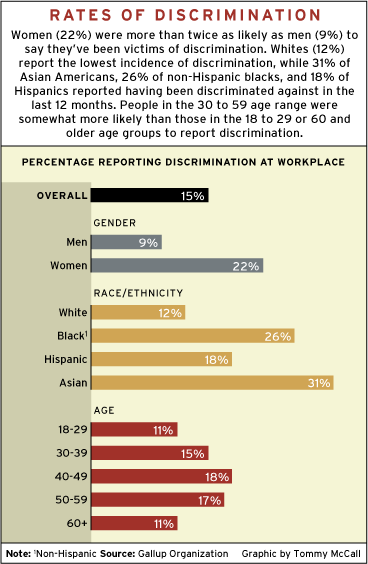 |
In the workplace, diversity is not, or should not, be a matter of numbers. Rather, workplace diversity should be viewed as a culture of open communication, trust, and inclusiveness aimed at building a better, more competitive organization. Why? Because an organization free of discrimination is not just a better place to work, it's an organization that works better.
The business of diversity
The issue of workplace diversity has claimed a tremendous amount of business' money, time, and energy. But has all that effort significantly prevented discrimination? And though diversity is good for society, how good is it for business?
To find answers to these and other questions, Gallup, with support from Kaiser Permanente, the Society for Human Resource Management, and United Parcel Service, conducted a national poll on discrimination last year, ultimately releasing a report on "Employee Discrimination in the Workplace" in December 2005. Gallup surveyed Americans who are currently employed, had been employed in the last two years, or were actively seeking employment.
Fifteen percent of all respondents said they have been discriminated against in their workplace, for some reason, in the past 12 months. "That's a very significant number," says David Grinberg, senior public affairs specialist at the Equal Employment Opportunity Commission (EEOC). "Even forty years after the EEOC was created, American workers still face a lot of discrimination."
Men (9%) were much less likely than women (22%) to say they've been victims of discrimination. At 12%, whites reported the lowest incidence of discrimination, while 31% of Asian Americans, 26% of non-Hispanic blacks, and 18% of Hispanics reported having been discriminated against in the last 12 months. The youngest and the oldest respondents weren't any more likely to say they have experienced discrimination; people in the 30 to 59 age range were somewhat more likely than those in the 18 to 29 or 60 and older age groups to report discrimination.
Of those who said they've been discriminated against, 26% reported that the discrimination was based on gender, 23% said race or ethnicity, 17% said age, 12% cited favoritism or nepotism, and 9% said disability.
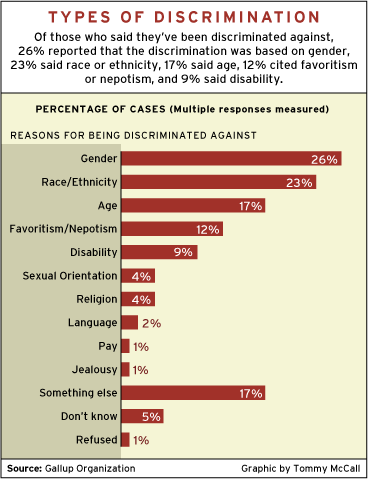 |
Antidiscrimination laws prohibit employers from retaliating against employees who report or corroborate discrimination. Yet 42% of respondents -- regardless of whether they have experienced discrimination -- expect employers to retaliate against employees. This percentage is sharply higher among those who said they have experienced discrimination; 67% of those who felt they'd been discriminated against believe employers retaliate against employees who speak up. And there are a number of groups in which a majority are suspicious of retaliation: women, the least educated, and racial and ethnic minorities. Forty-six percent of women, 52% of people without a high school education, 54% of blacks, and 52% of Hispanics said employers react negatively toward employees who claim discrimination.
Diversity focus
If an employee in your organization complains to management that he or she has been discriminated against, consider it relatively good news. To a certain extent, claims of discrimination indicate a positive focus on diversity; people are more likely to come forward when they believe that company leaders really care about diversity, are fair, and won't retaliate against complainants.
The Gallup study shows that 72% of respondents who strongly disagreed that employers retaliate against those reporting discrimination agreed that if they personally experienced discrimination at their workplaces, they'd be confident their employers would resolve the issue in a "fair and just manner" once they raised it. In other words, a discrimination complaint can be a signal of trust as well as an indicator that some action should be taken immediately.
But what action? Though many organizations have established protocols for handling discrimination complaints, the actual filing of a claim often precipitates a tense, emotional situation for all involved. Managers are often dismayed when unexpected complaints of discrimination arise -- or worse, when they find that they have been named as a discriminator. Nonetheless, companies have an obligation to respond.
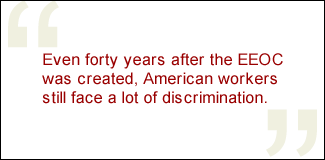 |
A good first step is for the people involved to talk about the problem. Karen Higginbotham, the director of the office of civil rights at the Environmental Protection Agency (EPA), says, "People should always seek resolution at the lowest level first. An open and honest conversation between the two people involved to work out the issue can defuse the issue before it escalates." If a discrimination complaint is based on misperceived behavior, discussion can often resolve problems before they worsen.
But that conversation can only happen if employees believe that their opinions will be heard, will be taken seriously, and will be responded to appropriately -- in other words, in an atmosphere of trust. Trust in the implicit fairness of management is a crucial component of workplace satisfaction.
This is why personal perceptions of diversity go well beyond simply increasing the numbers of legally protected groups at your company. In other words, recruiting more people from protected groups, such as minorities and women, is less important than promoting a culture of trust. The goal should be to create a culture of trust in your organization by focusing on workplace diversity. If employees lack confidence in leadership on issues of blatant and illegal mistreatment, no one -- even workers who aren't members of a legally protected group -- will feel safe about reporting discrimination or standing up for victims.
The survey included seven questions that, taken together, indicated respondents' perceptions of their workplaces' diversity focus (WDF). (See sidebar "Workplace Diversity Focus Items.") Workforce diversity focus is highly correlated with important workplace attitudes. According to the survey results, employees whose companies have lower WDF scores are less likely to feel satisfied with or loyal to their company -- and they're also less likely to stay with their employer -- than employees whose companies have higher WDF scores.
|
Workplace Diversity Focus Items These seven questions, taken together, indicate respondents' perceptions of their workplaces' diversity focus (WDF), which correlates highly with important workplace attitudes. Employees whose companies have lower WDF scores are less likely to feel satisfied with or loyal to their company -- and they're also less likely to stay with their employer -- than employees whose companies have higher WDF scores.
|
While the study shows that relatively few workers report having experienced discrimination, the findings also reveal that if employees believe that their organization truly emphasizes diversity and takes action when discrimination occurs, it has an enormous impact on workplace attitudes such as job satisfaction.
The people with the highest WDF scores -- the top quartile of scores -- were the most satisfied (70%) with their workplace, while the people with the lowest WDF scores -- the bottom quartile -- were the least satisfied (19%). WDF scores in the top quartile correlated with worker loyalty (74% said they would recommend their organization as a place to work), while WDF scores in the bottom quartile correlated, of course, with less loyalty (only 18% said they would recommend their company).
WDF scores also show a relationship to worker retention. Employees with the highest WDF scores were mostly likely (84%) to say they would stay with their employers, and those with the lowest scores were most likely (48%) to say they wanted to work somewhere else.
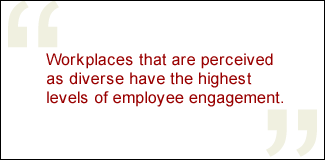 |
Profiting from diversity
Business leaders are legally obligated to ensure that their workplaces are free of discrimination. From an employee's perspective, though, it's not enough to assume that your rights are valued and protected. Indeed, it should be obvious that those in authority positions, from local management to the executive team, are genuinely focused on fairness and equal opportunity through diversity.
According to the Gallup survey, of respondents who "strongly agreed" that the head(s) of their company or senior leadership are committed to diversity, 57% were "extremely satisfied" with their workplace, 64% "strongly agreed" that they would recommend their place of work to family or friends, and 80% "strongly agreed" that they plan to be with their organization in the near future. These numbers show the power that leadership efforts to communicate and emphasize the importance of diversity can have on employees' workplace attitudes.
But there's also an economic aspect to consider. Workplaces that are perceived as diverse have the highest levels of employee engagement, and engagement is crucial to the financial health of any organization. Gallup research indicates that engaged employees are more productive, profitable, safer, create stronger customer relationships, and stay longer with their company than less engaged employees. Employees who aren't engaged, on the other hand, cost businesses in lost productivity, worker's compensation claims, and wasted time -- they cost much more than they're worth.
Results of this study showed that 60% of workers who with the highest WDF scores (those in the top quartile) are engaged versus 11% of those who with the lowest scores (those in the bottom quartile). In contrast, 38% of those with the lowest WDF scores (again, those in the bottom quartile) were actively disengaged.
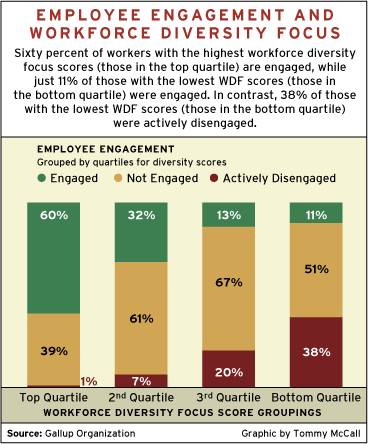 |
Discrimination drives workers out, turns enthusiasm into fear, creates cynicism, and hobbles productivity. It should be said, however, that disengaged employees are not necessarily bad employees. The cognitive and emotional costs of dealing with a negative environment can drive good employees to feel constrained and less productive.
Thinking of diversity as a numbers game isn't the key to leveraging the power of diversity. What matters is that the organization as a whole, from senior leadership on down, is committed to creating a climate of fairness and opportunity. As the results from the Gallup study show, organizations that can do this successfully will most likely have higher employee satisfaction, greater loyalty, and increased employee retention.
Building trust
High WDF scores don't necessarily come from the annual diversity or cultural competence workshop, a human resources brochure that's easily discarded, or a "Know Your Rights!" poster in the break room. Within organizations, leadership sets the tone for what the organization is committed to, and at top workplaces, that includes a commitment to diversity. However, perceptions of diversity are strongly influenced by the actions of each employee's local manager, and managers can easily undermine or inhibit the commitment developed and communicated by senior leadership. For an organization to build trust successfully, the message needs to be the same at every level of the organization, from top management on down: that every employee should have the opportunity to work in an environment that is open to diverse ideas, cultures, and talents -- and is free from discrimination.
However, it's not easy to get employees to trust management if they've seen promises made and broken, or friends and colleagues inexplicably dismissed, reassigned, or passed over for jobs or promotions. Distrust can crush worker morale, and more importantly, employee engagement. If management wants to encourage creative and innovate thinking in the workplace, they must first set the stage for a climate that emphasizes the inclusiveness of both ideas and workers of different backgrounds, ages, genders, and ethnicities.
Transparency, through open and consistent communication between management and staff, is the key factor in building trust, and trust is a key factor in worker perceptions of fairness and equal opportunity. Processes and procedures for hiring, promotion, and growth opportunities must be transparent so that employees understand the business reasons for management actions. And companies should consistently, and publicly, discuss the organization's definitions of and goals for workplace diversity.
If management communicates the organization's focus, vision, and goals for promoting a truly diverse workplace clearly and frequently, employees will both understand the employer's direction and plan for success. And workers will make job-market decisions based on organizational actions.
"Fairness and diversity are overarching considerations in all aspects of organizational functionality," says Higginbotham. "A variety of people will always bring forth a greater number of ideas and provide a host of viable solutions. All organizations can benefit from diversity."
Grinberg of the EEOC agrees, and puts it more bluntly: "Discrimination is just bad business. Most savvy employers know that."
Gallup contacted 1,252 adults, aged 18 and older, between April-June 2005, who were either currently employed, had been employed within the past two years, or were actively seeking employment. A disproportionate random sampling plan was used to permit breakouts of racial/ethnic minorities. Included in the final analysis were 302 African-American respondents, 310 Hispanics, 104 Asians, 492 whites, and 44 individuals in the "Other" category. For results based on the entire sample, one can say with 95% confidence that the maximum error attributable to sampling and other random effects is ±3 percentage points. For results based on smaller sample sizes, the maximum error attributable to sampling and other random effects would be higher. In addition to sampling error, question wording and practical difficulties in conducting surveys can introduce error or bias into the findings of public opinion polls.
